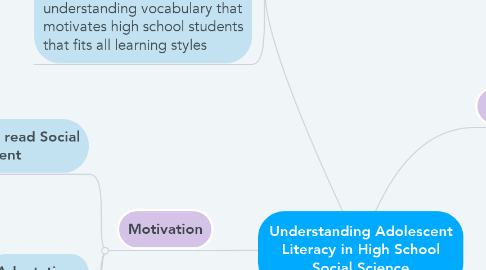
1. Introduction:
1.1. Requirements for Academic Literacy in Social Science
1.2. Implementation of strategies to motivate and provide scaffolding instructions
1.3. Teaching academic literacy in social science requires understanding vocabulary that motivates high school students that fits all learning styles
2. Motivation
2.1. Motivating students to read Social Science academic content
2.1.1. Guthrie
2.1.1.1. Children need a combination of intrinsic and extrinsic motivations to read. But without INTRINSIC motivation to read, children will not become lifelong readers. --Guthrie & Wigfield, 1997
2.1.2. Scaffolding approach
2.1.3. Engagement reading (Intrinsic vs. extrinsic)
2.2. Adaptations
2.2.1. 1. Simplifications of readings
2.2.2. Modifications
2.3. ESL learners
2.3.1. Cummins
2.3.2. ELD Learning
2.3.2.1. 4 Language skills
3. Conclusion
3.1. Social Science literacy reinforces academic literacy
3.2. Vocabulary, Motivation, and understanding styles
3.3. Teaching academic literacy in social science requires understanding vocabulary that motivates high school students that fits all learning styles
4. References
4.1. Swanson, E., Wanzek, J., McCulley, L., Stillman-Spisak, S., Vaughn, S., Simmons, D., Fogarty, M., & Hairrell, A. (2016). “Literacy and text reading in middle and high school social studies and English language arts classrooms”: Correction. Reading & Writing Quarterly: Overcoming Learning Difficulties, 32(4), 397. https://doi.org/10.1080/10573569.2015.1117901
4.2. Poch, A. L., & Lembke, E. S. (2018). Promoting Content Knowledge of Secondary Students with Learning Disabilities through Comprehension Strategies. Intervention in School and Clinic, 54(2), 75–82
4.3. Lloyd, G. M. ., Arbaugh, F., Knight, S. L. ., Edmondson, J., Nolan, J., McDonald, S. P. ., & Whitney, A. E. (2012). Beyond the Teacher Certification Program Debate: From Models to Features. Journal of Teacher Education, 63(3), 169–170. https://doi.org/10.1177/0022487112437717
5. Vocabulary
5.1. The SIOP® Model
5.1.1. Krashen- Acquisition of language vs. learning language
5.1.2. Accommodations (giving student access) and modifications
5.2. CCSS
5.2.1. Complex literacy and informational text
5.2.1.1. Social Studies Specific
5.2.1.2. Historical thinking/ literacy needs
5.2.2. Habits of mind
5.2.2.1. Learning on the diagonal
5.3. Cummins
5.3.1. CALP vs BIC
5.3.2. ESL learners
6. Learning Styles
6.1. 5 Essentials components for social justice education
6.1.1. Tool 1: Content Mastery
6.1.2. Tool 2: Critical Thinking and the Analysis of Oppression
6.1.3. Tool 3: Action and Social Change
6.1.4. Tool 4: Personal Reflection
6.1.5. Tool 5: Awareness of Multicultural Group Dynamics
6.2. Historical thinking/ literacy needs
6.2.1. NCSS- National Council for the Social Studies
6.2.2. Standard #10
6.2.3. Paulo Freire
6.3. Teaching and learning with teenagers
6.3.1. Neuroscience of Learning
6.3.2. Multiple intelligence
